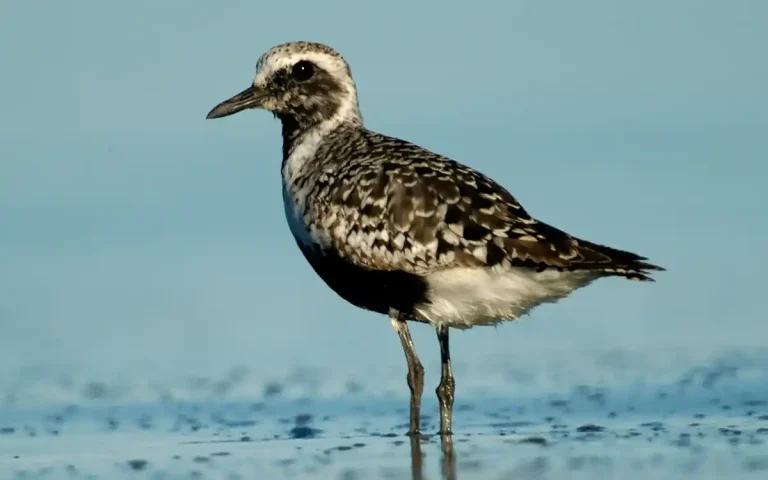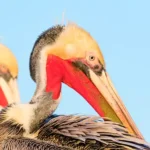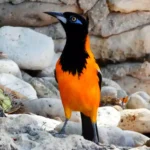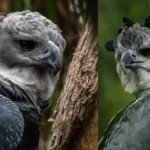Texas is home to over 600 bird species, making it one of the best states for birdwatching in North America. Among this diversity, the yellow-belly birds of Texas stand out with their vibrant colors and lively songs.
Whether in grasslands, wetlands, forests, or backyards, these bright birds are a delight to spot.In this guide, we’ll cover 10 yellow-belly birds found in Texas — from the tiny Common Yellowthroat to the glowing Prothonotary Warbler. We’ll highlight their identifying features, habitats, behaviors, and the best places and times to see them.
1. American Goldfinch (Spinus tristis)
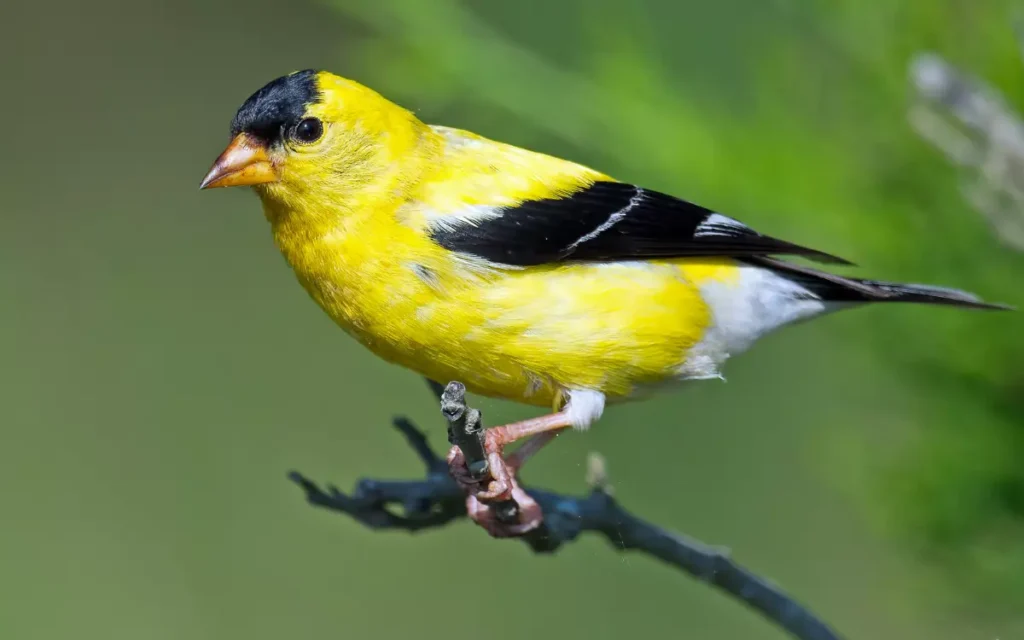
The American Goldfinch is a small finch with a brilliant yellow body, black wings, and a cheerful “potato-chip” flight call. In Texas, they are common winter visitors, gathering in fields, woodlands, and gardens. Males turn bright yellow in summer breeding plumage, while females remain olive-yellow year-round. They feed mostly on seeds, especially Nyjer and sunflower, and are easy to attract with backyard feeders. Acrobatic and social, they often feed upside-down in flocks.
- Length: 4.3 – 5.1 in(11 – 13 cm)
- Weight: 0.4 – 0.7 oz (11 – 20 gm)
- Wingspan: 7.5 – 8.7 in (19 – 22 cm)
2. Common Yellowthroat (Geothlypis trichas)
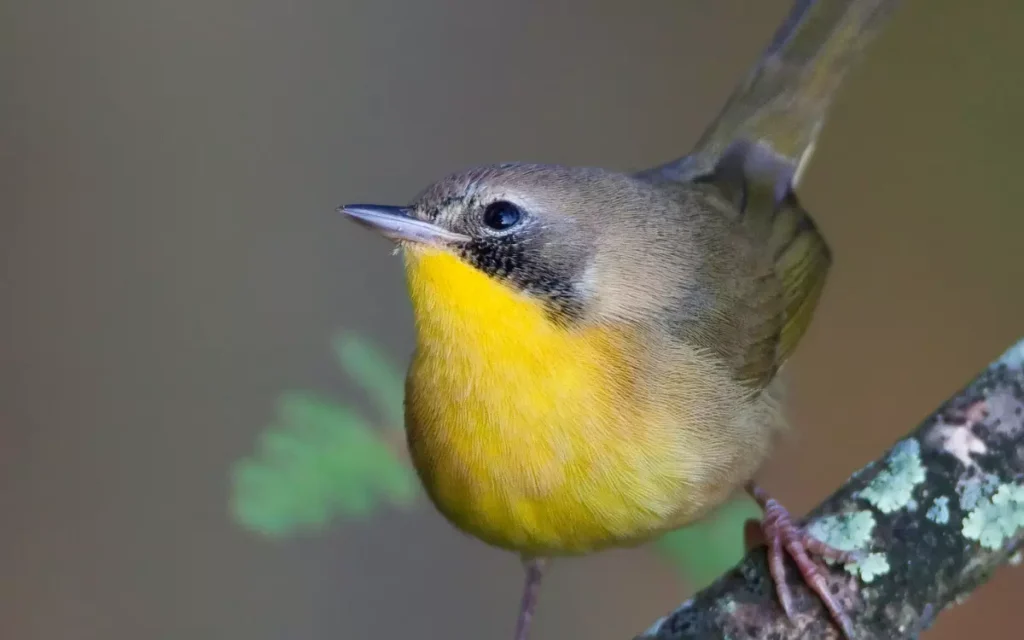
This small warbler has olive upperparts and a bright yellow throat and belly, with males featuring a bold black mask. Common Yellowthroats thrive in Texas wetlands, marshes, and brushy thickets. They are secretive birds, usually hiding in low vegetation, but their “witchety-witchety-witchety” song gives them away. They feed mostly on insects and spiders and are seen during migration seasons across Texas, though some remain year-round in the south.
- Length: 4.3 – 5.1 in (11 – 13 cm)
- Weight: 0.3 – 0.3 oz (9 – 10 gm),
- Wingspan: 5.9 – 7.5 in (15 – 19 cm)
3. Yellow-breasted Chat (Icteria virens)
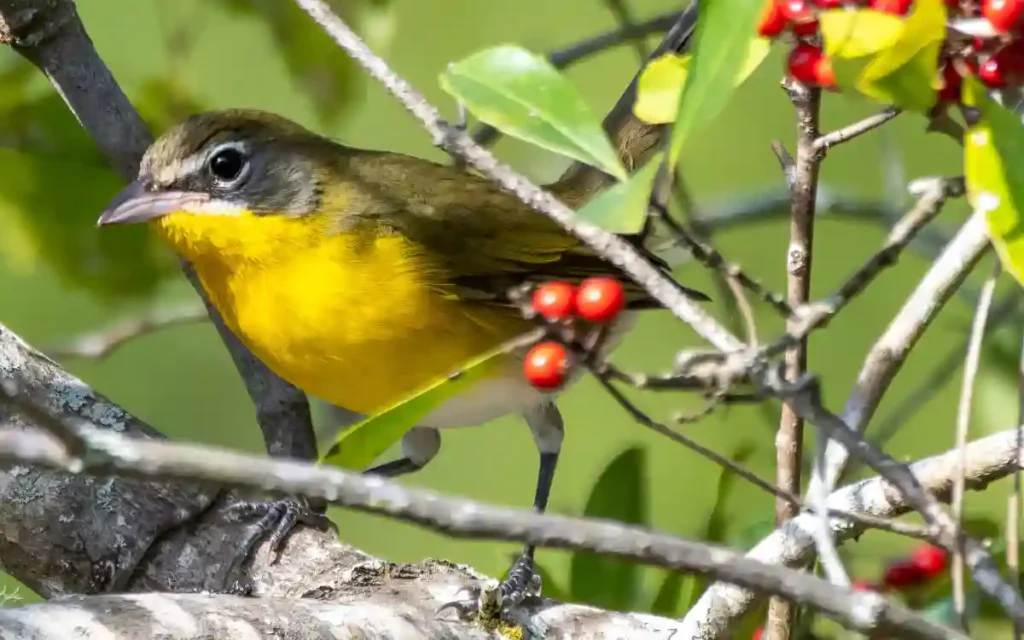
The Yellow-breasted Chat is the largest warbler in North America, with an olive back, bright yellow breast, and white belly. Found in dense Texas thickets and scrubby areas, they are often heard before seen. Their calls include whistles, cackles, and gurgles, making them one of the most unusual singers among birds. Chats are summer breeders in Texas, migrating south in winter. Despite their size, they remain secretive, preferring to skulk in dense vegetation.
- Length: 7.1 in (18 cm)
- Weight: 0.8 – 1.1 oz (23 – 31 gm)
- Wingspan: 9.8 in (25 cm)
Read also:
4. Western Kingbird (Tyrannus verticalis)
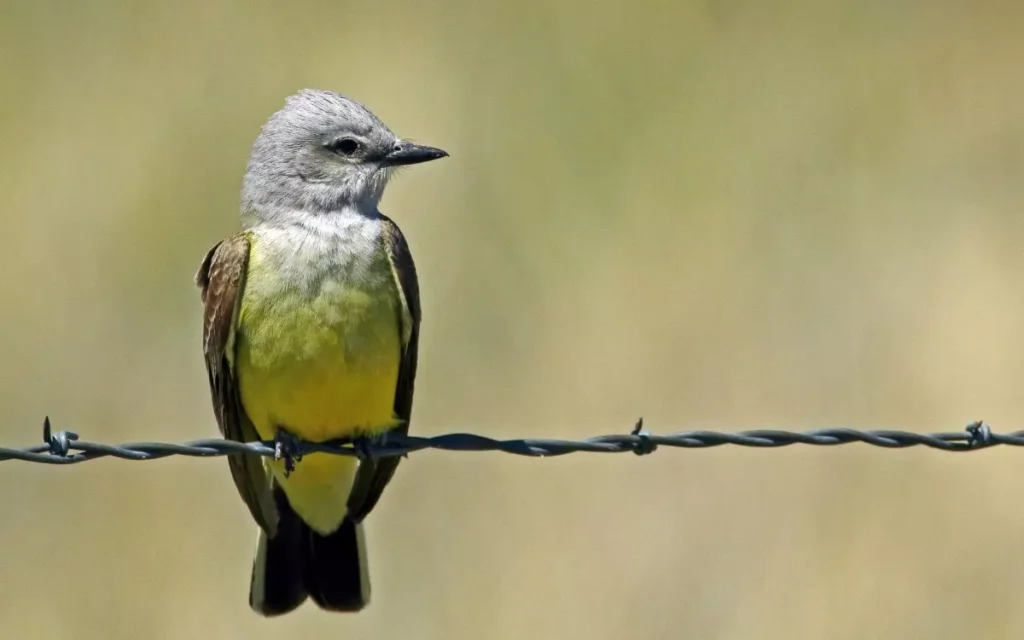
Easily spotted on fence posts and wires, the Western Kingbird has a gray head, lemon-yellow belly, and black tail with white edges. These flycatchers dominate open Texas landscapes like grasslands and farmlands, where they perch and sally out to catch insects midair. Known for their boldness, they aggressively chase away much larger birds. They’re common during Texas’s breeding season, adding flashes of yellow to rural skies throughout spring and summer.
5. Great Crested Flycatcher (Myiarchus crinitus)
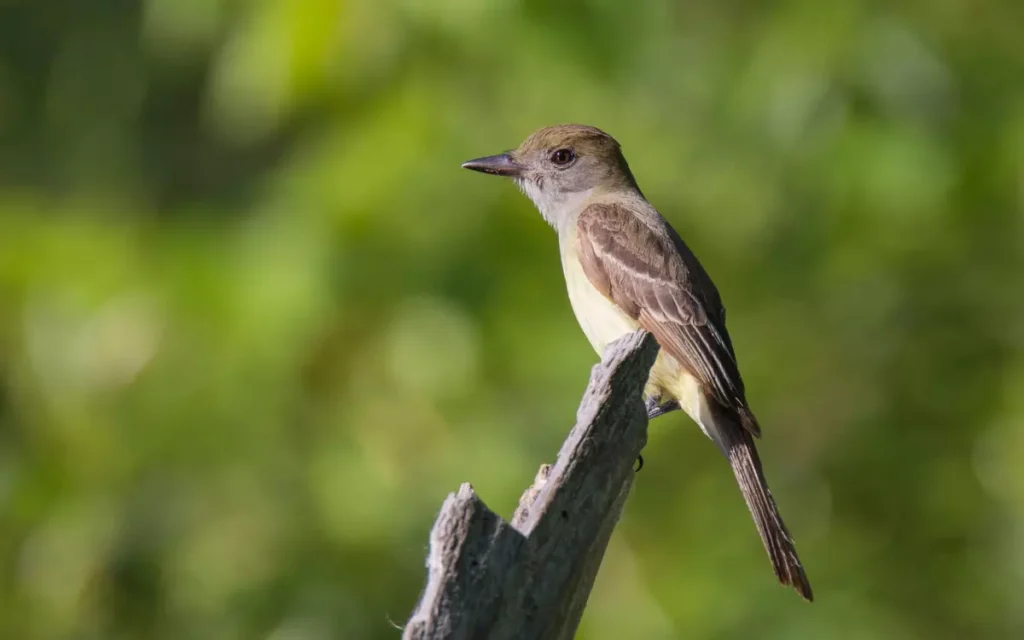
This large flycatcher has olive-green upperparts, a gray throat, and a bright lemon-yellow belly. In Texas woodlands, they are more often heard than seen, with their loud “wheep” call echoing through forests. They nest in tree cavities, sometimes lining them with shed snake skins — a unique trait among birds. Feeding mostly on insects, they forage high in the canopy but will also eat fruits. They are summer breeders in much of Texas.
- Length: 6.7 – 8.3 in (17 – 21 cm)
- Weight: 0.9 – 1.4 oz (27 – 40 gm)
- Wingspan: 13.4 in (34 cm)
6. Eastern Meadowlark (Sturnella magna)
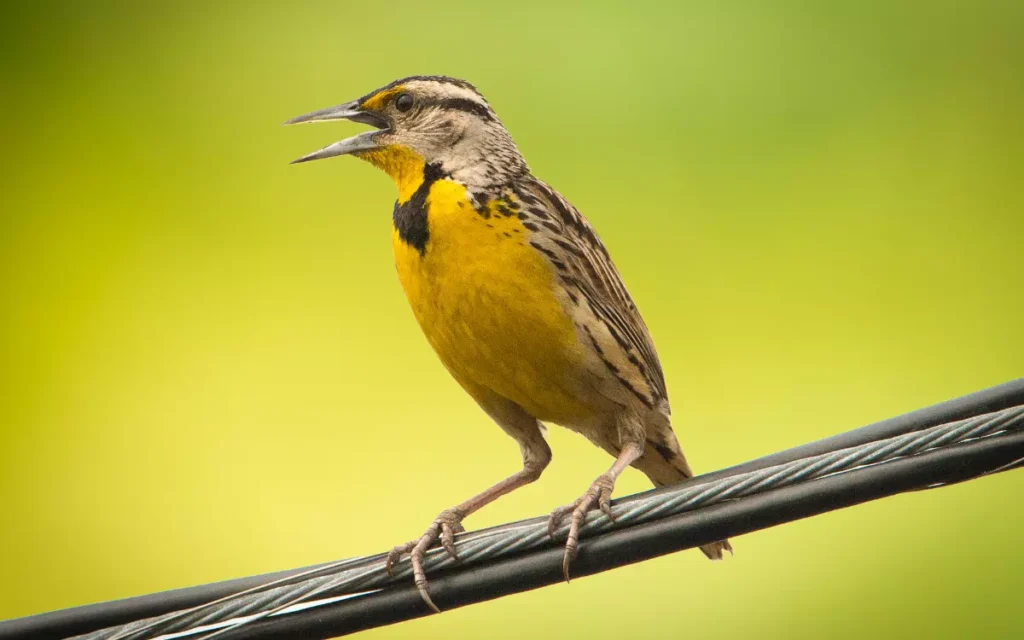
The Eastern Meadowlark is a medium-sized bird with a yellow belly, a bold black “V” across the chest, and brown-streaked upperparts. Common in Texas grasslands and meadows, they forage on the ground for insects and seeds. Their clear, flute-like whistles carry across open landscapes in spring and summer. Year-round residents in Texas, meadowlarks are often seen perched on fence posts or foraging in fields, making them a familiar sight in rural areas.
- Length: 7.5 – 10.2 in (19 – 26 cm)
- Weight: 3.2 – 5.3 oz (90 – 150 gm)
- Wingspan: 13.8 – 15.8 in (35 – 40 cm)
7. Hooded Warbler (Setophaga citrina)
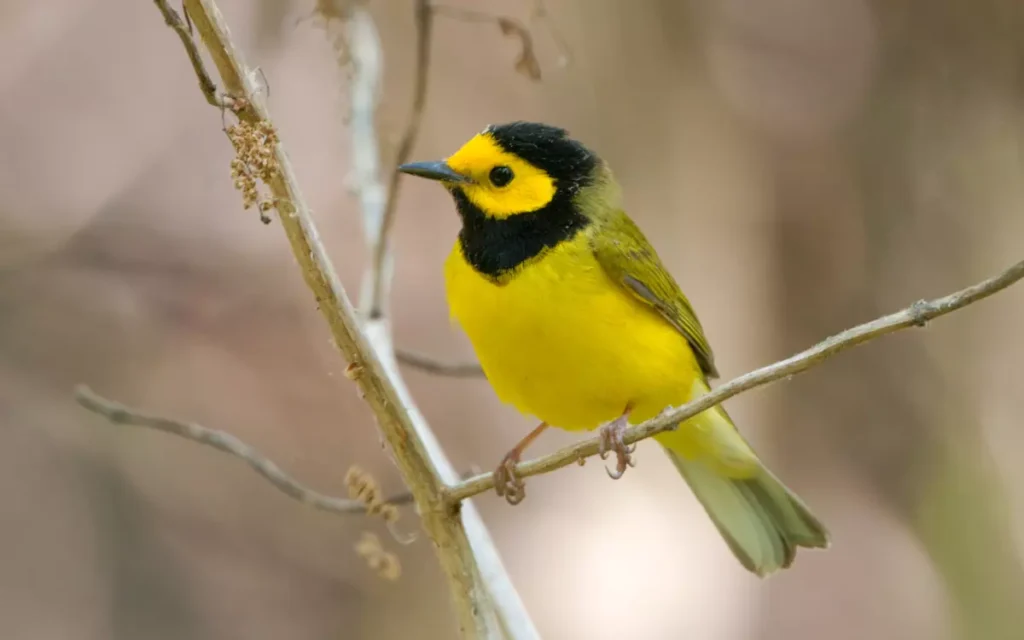
The Hooded Warbler is one of the most striking yellow-belly birds in Texas, with a bright yellow face and belly framed by a jet-black hood. They prefer dense forest understory, where they dart quickly after insects. In Texas, they are most common during spring and fall migrations, though some breed in the east. Males sing a clear, ringing song to defend territories, making them easier to find despite their shy, fast-moving behavior.
- Length: 5.1 in(13 cm)
- Weight: 0.3 – 0.4 oz (9-12 gm)
- Wingspan: 6.9 in (17.5 cm)
8. Prothonotary Warbler (Protonotaria citrea)
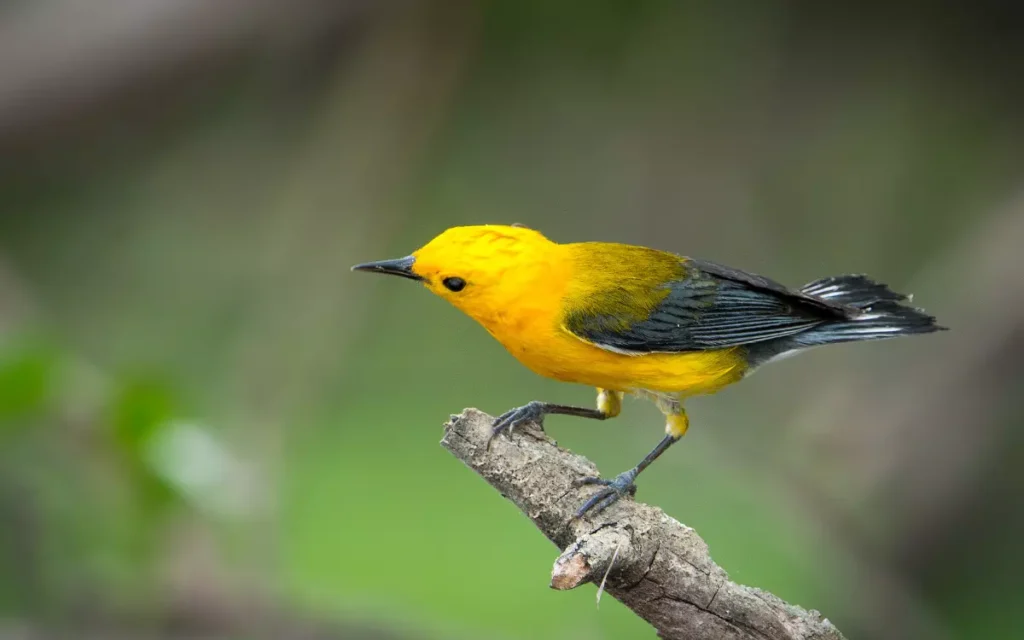
Nicknamed the “golden swamp warbler,” this glowing bird has a golden-yellow body with blue-gray wings and tail. In Texas, they inhabit swamps, rivers, and wet forests, especially in the east. Unlike most warblers, they nest in tree cavities, often near water. Feeding on insects, snails, and spiders, they are agile hunters among branches and vegetation. Their loud, ringing “sweet-sweet-sweet” song is a hallmark of Texas wetlands during the breeding season.
- Length: 5.5 in (14 cm)
- Weight: 0.56 oz (15.88 gm)
- Wingspan: 8.75 in (22.23 cm)
9. Yellow Warbler (Setophaga petechia)
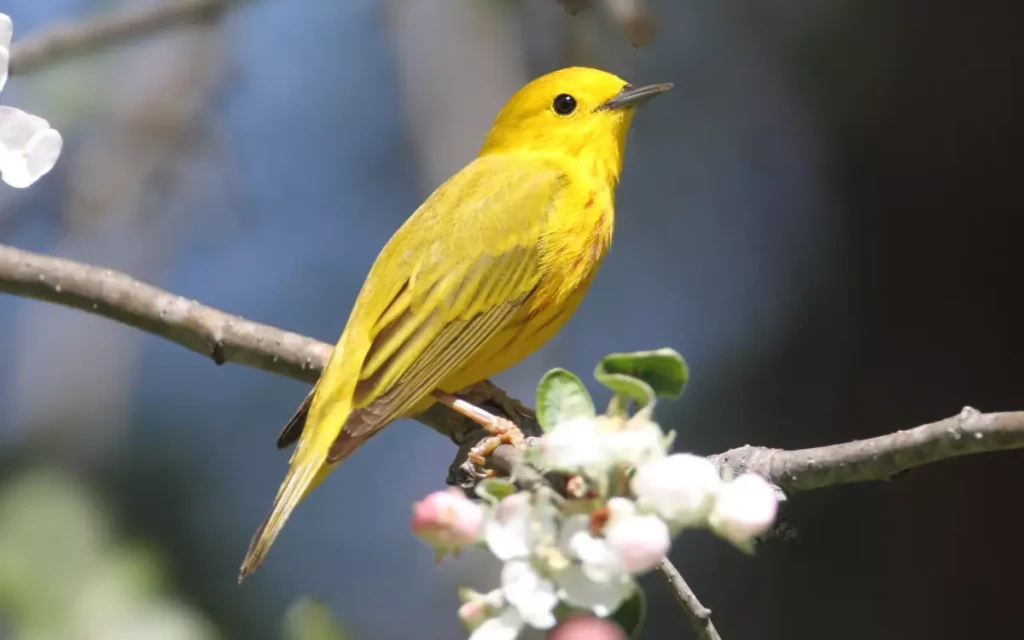
The Yellow Warbler is one of the brightest all-yellow birds in Texas, with males showing reddish streaks on the breast. They frequent woodlands, streamside thickets, and edges during spring migration, when they are most common in Texas. Their sweet “sweet-sweet-sweet-I’m-so-sweet” song makes them easy to recognize. Feeding mainly on insects, they are vital in keeping pest populations in check. Though only passing through, their glowing plumage brightens Texas during migration.
- Length: 4.7–5.1 in (12–13 cm)
- Weight: 0.3–0.4 oz (9–11 g)
- Wingspan: 6.3–7.9 in (16–20 cm)
10. Western Tanager (Piranga ludoviciana)
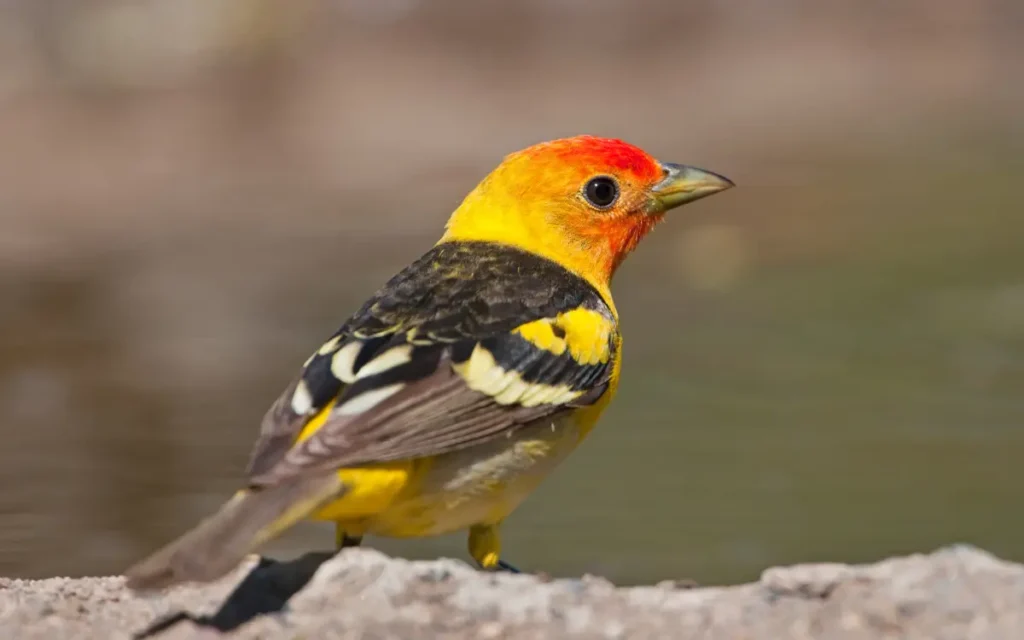
Though rare, the Western Tanager is an occasional Texas visitor during migration. Males are striking with a red face, bright yellow body, and black wings, while females are duller yellow-green. They prefer coniferous habitats in their main range but may be spotted in Texas woodlands and parks while migrating. Feeding on insects and fruits, they are shy but unforgettable when seen. Their vibrant colors make them one of the most beautiful yellow-belly birds.
- Length: 6.3–7.5 in (16–19 cm)
- Weight: 0.8–1.3 oz (24–36 g)
- Wingspan: 11.5 in (29 cm)
Habitat & Birdwatching in Texas
Texas’s size and ecological diversity make it a paradise for birdwatchers. Yellow-belly species can be spotted in many regions:
- Rio Grande Valley: Excellent for warblers and kingbirds.
- Big Bend National Park: Great for chats and meadowlarks.
- Texas Hill Country: American Goldfinches and flycatchers.
- East Texas Wetlands: Prothonotary and Hooded Warblers.
For the best results, go birdwatching early mornings or late afternoons with binoculars and a field guide. Also keep an eye out for the Northern Mockingbird, Texas’s beloved state bird.
FAQs
What birds in Texas have yellow bellies?
Some common ones include American Goldfinch, Common Yellowthroat, Yellow-breasted Chat, Eastern Meadowlark, and Prothonotary Warbler.
Where can I go birdwatching in Texas to see them?
Top spots include Rio Grande Valley, Big Bend National Park, and East Texas wetlands.
Are yellow-belly birds rare in Texas?
No — many are regular residents, while others migrate through Texas each spring and fall.
Which yellow birds can I see in my backyard?
American Goldfinches, Common Yellowthroats, and Western Kingbirds are often spotted near homes and gardens.
What is Texas’s state bird?
The Northern Mockingbird is the state bird, though it does not have a yellow belly.
Conclusion
From the golden Prothonotary Warbler to the bold Western Kingbird, the yellow-belly birds of Texas add brilliance and life to fields, forests, and wetlands across the state. Their songs, colors, and behaviors make them some of the most memorable species for birdwatchers.
Next time you’re outdoors, keep your binoculars ready — a flash of yellow might reveal one of these 10 stunning birds.


